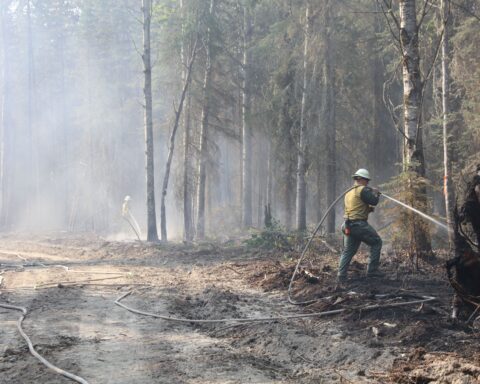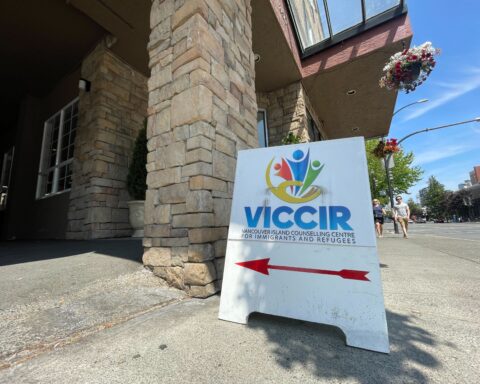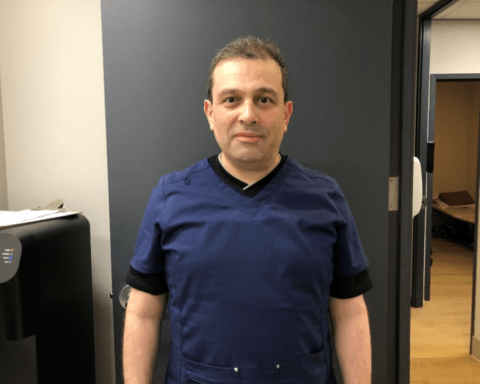Nishaat Sheraly shuffles into a small lounge area, tugging at her IV tube as her husband, Munsif, escorts her. As she sits down, she adjusts the black-and-white silk scarf carefully wrapped around her head, concealing any wayward strands of hair.
She gives a weak smile, almost apologetic. It’s perhaps all Nishaat can muster after her latest round of in-patient chemotherapy at Toronto’s Princess Margaret Hospital. It is a bitter case of déjà-vu for this 37-year-old mother of two boys.
Nishaat was first diagnosed with leukemia in 2011, just a week before Christmas. Several rounds of chemotherapy later and she was in remission. But midway through July this year, a routine check-up revealed a dangerously low platelet count. She had relapsed.
The Richmond Hill area high school teacher barely had any time to process the news before she was whisked away for aggressive treatment. It soon became painfully clear – she would once again have to spend a month at the hospital, be isolated from much of her family, undergo chemo, have her blood assessed and wait to find out when – if ever – she’d be ready for a bone marrow transplant.
Beating the odds
Bone marrow transplant is a procedure that restores stem cells that are destroyed by high doses of chemotherapy and/or radiation therapy. It is done by extracting the flexible tissue found in a healthy donor’s bones. A successful transplant usually depends on the patient’s age, how aggressive the leukemia is and the quality of the match.
Finding a match, however, is a challenge. Nishaat has been on the international bone marrow registry for more than two years and there hasn’t been a single match for her – anywhere in the world.
“For any patient that’s been diagnosed with a disease that requires a stem cell transplantation, you only have a 25 per cent possibility that you’re going to find a match within your family,” says Mary-Lynn Pride.
Pride is the Patient and Transplant Liaison Specialist for Canadian Blood Services. She walks patients through the search process of finding a bone marrow match.
“We recognize that for any patient that needs a stem cell transplant, their best hope of finding a match is going to be from their own ethnic community,” says Pride. In Nishaat’s case, that would mean a South Asian donor. But that in itself, is another challenge.
Fighting ignorance
According to CBS, approximately 342,000 Canadians are registered, but only 3.6 per cent are from the South Asian community.. Another one per cent is from the Black (or Caribbean) communities and the First Nations communities respectively. The lion’s share is made up of Caucasian donors with 71%.
Munsif attributes the shortage to “a lack of awareness, a lack of education, anxiety around the process and apathy.”
“I think people are just so afraid of the process,” adds Nishaat. “They really feel like you’re taking something from them that cannot be replaced. When you look at minorities, even religiously speaking, the whole notion of organ donation is a major issue. So when it comes to bone marrow or stem cells, I think some of that falls into the same category. In terms of the mentality.”
The cultural stigma is so strong that some discourage their family from accepting donated organs even if a match is found. In one case, a Stanford professor had found a match for a South Asian couple’s 20-something son, but the young man’s parents convinced him at the last minute to refuse the donation.
Donating
Donors must be between 17 and 50 years of age to be eligible, although the ideal age range is between 17 and 35, as younger donors provide better post-transplant recovery for patients. They must be in overall good health, readily available and have Canadian health card coverage. The Canadian Blood Services (CBS) is particularly looking for male donors from different ethnic communities. CBS says donors can return to their normal activities within a day or two; their stem cells reproduce within four to six weeks. Moreover, the quality of their health is not impacted.
CBS supports the OneMatch Stem Cell and Marrow Network as well as the National Cord Public Blood Bank. OneMatch is a program that has been in existence since 1988 and is mandated to find stem cell patients.
In the event that an adult donor cannot be found, a patient can receive a transplant from umbilical cord blood after the birth of the child, but the donor blood still must be a match. The National Public Cord Blood Bank already has centres operating in Ontario, with another two set to open in Edmonton and Vancouver later this year.
If a donor is a match, there are usually two ways to donate:
1) Bone Marrow procedure: This is considered to be a surgery, done under general anesthetic. Doctors make small bandage-sized incisions at the top of the hipbone as guides that go into the actual bone itself to extract the stem cells required. The donor may have a bit of tenderness or bruising after the procedure.
– OR-
2) Peripheral Stem Cell procedure: This is similar to blood donation, in that a needle would be inserted into their arm. The blood travels through a sterile machine, which then extracts the required stem cells. All other blood products – white blood cells, red blood cells, and platelets – subsequently return to the donor through another needle in the other arm. Prior to the procedure, the donor is given injections of a medication that overproduces the stem cells in the marrow to ensure they will flow out into the circulating blood.
Community outreach
‘South Asians 4 Life’ is one group partnering up with CBS in trying to combat the deep-rooted stigma through awareness campaigns. According to their website, 5,000 South Asians have registered with the OneMatch Stem Cell and Marrow Network**. As of 2011, there were nearly 1.6 million South Asians living in Canada, the largest visible minority group in the country (StatsCan). At the time of this article, 28 Canadian patients of South Asian descent were also reportedly waiting for a match.
“People actually have the opportunity to change the numbers,” says Munsif. “To make a positive impact. If they knew about it and if they thought or understood it could happen to their loved ones, they would have no hesitation to do it.”
Munsif says various community centres in the GTA have been “very supportive and extremely accommodating,” of their cause, by holding bone marrow donor drives more than two years ago in Nishaat’s name. From there he realized there were many misconceptions about signing up to be a donor.
“People equate the process to breaking bones and pulling stuff out,” he says, adding some attendees asked if the procedure was dangerous. He insists the processes of donating (or even recovery) are not painful.
The grim reality of donor shortages is hitting home for many ethnic groups across the country. In Toronto, multiple “Swab-a-Cheek” drives are being organized at religious and cultural centres throughout the month.
Western Canada is also taking part, using Bollywood as a catalyst for change. Famed singer Shreya Ghoshal will reach out to a Calgary audience in late August. The Alberta event is joining forces with CBS, with part proceeds from ticket sales going to a fundraising initiative for Canada’s National Public Cord Blood Bank. The concert will also help urge its South Asian audience to become donors.
Donor drive
Meanwhile, the Sheraly family is once more banding together with their Vaughan-area mosque – the Jaffari Community Centre – to host a donor drive on Aug.31.
If a donor doesn’t materialize by autumn, Nishaat says her medical team may explore other options, including clinical trials and reaching out to the National Public Cord Blood Bank, which could require living in another city for months on end for treatment. More than anything, all they want is to return to the way things used to be.
“I think for us, this is the journey of life and we’ve hit the pause button,” says Munsif, who says the experience has taken a toll on their seven and 10-year-old sons. “We would like nothing more than to return and resume our journey in life.”
“We just want that boring life,” adds Nishaat. “I just want to be with my family, watch my kids grow, watch them play hockey, build that ice rink in the backyard. Just normal. 100% so badly. I just want normal.”
To find out how you can be a Bone Marrow Donor, visit www.onematch.ca or dial 1-888-2-donate and request a swab kit. To follow Nishaat’s story, join the “NishStrong” Facebook group.




